In a world that always seems to be going after the latest exotic superfood, the most nutritious plants are sometimes hiding right outside your back door— literally.
Those who desire a perfect lawn or tend a garden might label these plants as “weeds,” but they have a lot more to offer than most people realize. True, many of them do have an enthusiastic growth habit, but that doesn’t take away from their outstanding health benefits.
In fact, many wild greens that are considered weeds rival the healthiest vegetables for nutrition content. Some have even been found to be more nutrient-rich than kale, which is really saying something!
Here’s more on this overlooked food source and the 10 healthiest edible weeds that might be in your backyard right now (plus an honorable mention).
What are Weeds? The Unwanted Plants
In general, the term “weed” simply refers to any plant that’s growing where it’s not wanted.
So, if you want to have a lawn full of dandelions, you can safely say that your dandelion-filled yard is weed-free.
That being said, most plants that are widely regarded as weeds also have other characteristics like a vigorous growth habit or a tendency to choke out other plants. They usually spread more easily and are harder to get rid of than cultivated plants.
Of course, there’s also a more serious category of weeds that are called “invasive”.
These will vary by region and are generally defined as non-native plants that aggressively take over natural ecosystems. You do not want them growing in your backyard but even some invasive weeds are edible and highly nutritious.
The bottom line is that most people have access to a 100% free food source that is usually available year-round.
Now, weed populations will vary greatly depending on location, so if you don’t have any of the following “super-weeds” in your yard, you may want to check for some local alternatives.
Important Note on Harvesting/Eating Weeds
Before we get to the healthiest weeds list, there are two important precautions you should keep in mind.
First, it’s critical that you make sure any weeds/plants you harvest come from an area that has not been sprayed with chemicals (pesticides, herbicides, etc.). You should know what does or doesn’t go on your own yard, but if you venture further afield, ask questions about chemical usage first.
Also, many of the following weeds are easily recognizable, but you should make sure of proper identification before picking (and eating) any plant.
Not all weeds are edible and some can be toxic, although most of the common ones are perfectly safe.
With that out of the way, here are the top best health-boosting weeds!
Top Healthiest Edible Weeds
Dandelion (Taraxacum officinale)

Dandelions are often seen as a nuisance, which is unfortunate because the entire plant is edible and highly nutritious— root, flowers, and leaves.
The leaves are an excellent source of vitamins A, C, and K as well as essential minerals like iron, magnesium, calcium, and potassium. They also contain smaller amounts of vitamin E, folate, and other B vitamins.
Dandelions roots are particularly rich in a prebiotic fiber known as inulin. This makes them excellent for gut health as long as you consume the whole root.
In addition, the entire dandelion plant is full of a powerful vision-boosting antioxidant known as beta-carotene. The flowers are also packed with other antioxidants known as polyphenols, which have documented disease-fighting effects.
Using Dandelion:
While the smaller leaves can be enjoyed raw in a salad or blended into a smoothie, older leaves have more bitterness and are better when cooked. The roots can be eaten like a root vegetable or in powder form. They can also be roasted and used to make a “coffee-like” beverage.
Flowers can be added to a salad or used as an edible garnish.
Plantain (Plantago spp.)

Plantain is just as common as dandelion in many areas but less noticeable. It typically grows in small to medium rosettes with broad (Plantago major) or long, thin leaves (P. lanceolata).
Most species of plantain are highly nutritious edible weeds. The leaves are particularly rich in calcium, vitamin A, vitamin C, and vitamin K. Studies have also found that plantain leaves contain compounds with anti-inflammatory properties.
One particular type of plantain— P. ovata— is the little-known source of psyllium seeds. Each plant can produce up to 15,000 seeds, which are commonly used to support digestive health and regularity. Interestingly, the leaves aid digestion as well and may help ease diarrhea.
Using Plantain:
Plantain leaves can be eaten fresh or cooked gently. The seeds are also edible but somewhat difficult to harvest. (You can find them in the store as psyllium husks or powder.)
Lamb’s Quarters (Chenopodium album)

Lamb’s quarters, also known as white goosefoot or pigweed, could well be considered a “super-weed” because of its nutrition content. It tastes not unlike spinach but beats out this favorite green in several areas.
Specifically, lamb’s quarters is exceptionally rich in calcium (up to 3 times the amount found in spinach). It contains about 65% of the recommended daily allowance (RDA) for vitamin A and 37% of the RDA for vitamin C in a one-ounce serving. The leaves also have a fair amount of essential minerals like manganese, calcium, copper, and iron.
Interestingly, lamb’s quarters is something of an “ancient cousin” to quinoa. And just like with quinoa, the seeds are edible and contain high amounts of protein.
Using Lamb’s Quarters:
The young shoots and leaves of the plant are tender and can be eaten raw. Older leaves are best when lightly steamed or sautéed. You’ll typically find these plants growing from early summer through fall.
Stinging Nettle (Urtica dioica)

With a name like stinging nettle, you might think it best to stay away from this plant. But while you definitely don’t want to go picking them with bare hands, stinging nettles are excellent edible weeds and have research-backed health benefits.
In the nutrition arena, nettle is rich in protein, vitamins A, C, and K, several B vitamins, calcium, iron, magnesium, potassium, and phosphorus. It also contains substantial amounts of polyphenol antioxidants and all essential amino acids.
Consuming stinging nettle or using it as a cream is linked to pain relief (specifically for arthritis). It’s also a commonly used remedy for seasonal allergies and has shown histamine-blocking effects in studies. Nettle appears to have diuretic effects as well.
Using Stinging Nettle:
If you are fortunate enough to have stinging nettle nearby, harvest it carefully using gloves. Always cook or dry the leaves before eating to get rid of the “sting”. Dried nettle can be made into a tea, or sauté the fresh leaves with garlic and lemon.
Purslane (Portulaca oleracea)
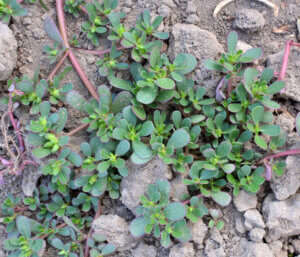
Purslane is a low-growing “weed” that has been eaten for at least 2,000 years. It grows happily in shady, disturbed areas (even in sidewalk cracks) and has small, succulent leaves.
The leaves have a mild nutty and slightly sour taste. They are loaded with nutrients like vitamin A, vitamin C, magnesium, manganese, potassium, iron, and calcium. Plus, purslane is one of the richest known plant sources of heart-healthy omega-3s. It contains about 5-7 times more omega-3s than other greens!
Purslane is also incredibly rich in antioxidants and even contains melatonin, the hormone that helps you fall asleep.
On another note, purslane leaves do contain oxalic acid, which may affect those prone to kidney stone.
Using Purslane:
Purslane leaves can be harvested anytime the plant is growing. They are easy to add raw to salads, soups, or smoothies and will even last in the fridge for a few days.
Chicory (Cichorium intybus)
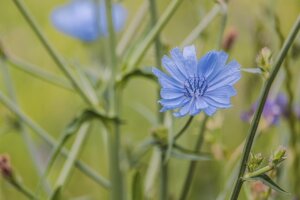
Unlike most of the other edible weeds on this list, chicory is valued more for its root than its leaves.
That’s not to say the leaves aren’t edible— though they are more bitter than dandelion leaves. The roots simply pack in more health benefits.
Perhaps the biggest benefit of chicory root is the fact that it’s very rich in fiber. It contains about 68% inulin by weight, which is a prebiotic fiber that feeds the beneficial bacteria in your gut and helps reduce inflammation. Inulin is also a natural constipation-reliever because it can help to soften stools and increase bowel movements.
Other studies have even shown that inulin can help improve blood sugar control.
Using Chicory:
You can harvest chicory root simply by digging up the plants and removing the thick taproot. The roots can be cleaned, peeled, and roasted. A 50-50 mix of roasted chicory and dandelion roots make a healthy herbal “coffee”. Or grind the roots into a powder to get the benefit of all the fiber.
Red Clover (Trifolium pratense)
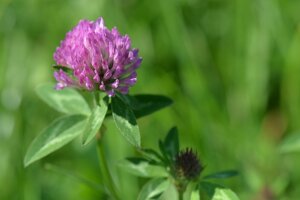
Think clover is just for livestock and bees? Think again.
Both the leaves and flowers of many clover varieties are nutritious, although red clover outshines the rest. It’s rich in nutrients like vitamin C, iron, and fiber but is especially notable for its isoflavone and polysaccharide content.
Both of these plant compounds possess anti-inflammatory properties and help prevent cell damage. They are also believed to contribute to the documented ability of red clover to help reduce menopausal hot flashes. Red clover isoflavones have even shown potential for lowering total and LDL (bad) cholesterol levels.
Using Red Clover:
If red clover grows in your yard, harvest the blossoms when they are in full bloom (avoid flowers that are turning brown or have mildew). Use the flowers fresh in salads and other dishes or dry them to make clover tea.
Milk Thistle (Silybum marianum)
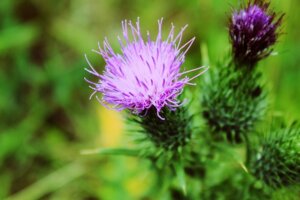
Thistles are often not a welcome sight in your garden or yard but they are truly some of the top health-boosting edible weeds.
You may be interested to learn that you can eat thistle flowers by cooking and peeling them to get to the tender “hearts” (very similar to artichokes, which belong to the thistle family). But the biggest value of milk thistle lies in a powerful compound known as silymarin that is often extracted from the seeds.
Silymarin has antioxidant, anti-inflammatory, and anti-viral properties. It has also demonstrated powerful liver-protective effects, including an ability to protect the liver against toxins and reduce liver inflammation and damage.
Using Milk Thistle:
You can harvest milk thistle seeds by cutting off the flower heads when they are dry and shaking the seeds out into a paper bag. More concentrated forms of silymarin are available in standardized milk thistle supplements.
Burdock (Arctium spp.)
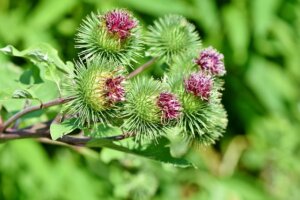
If you’ve ever had small burrs latch on to your clothing (or your pet’s fur), they could come from burdock.
This so-called weed is actually cultivated in other parts of the world and even considered a vegetable. The stems and shoots can be eaten, but the roots are typically considered the most valuable part of the plant.
To give you a quick overview, burdock root is full of potent antioxidants that fight free radicals and inflammation. Considered a blood purifier in Chinese medicine, some research has confirmed that compounds in the root can effectively remove toxins from the blood and improve circulation to the skin’s surface.
Perhaps because of these properties, burdock root has shown benefits for skin conditions like acne and eczema.
Using Burdock:
Harvest burdock roots by digging up the plant. You can do this at any time of year, but some foragers recommend fall or early spring as the best time. Use a sturdy shovel, since some roots weigh a few pounds!
Once harvested, clean and peel the roots. Roast them like any other root vegetable or grate raw over salads, etc.
Knotweed (Polygonum spp.)
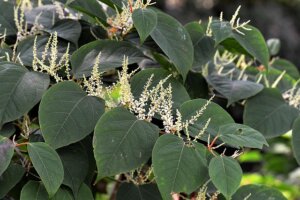
Knotweed has been used for thousands of years in traditional Chinese medicine (TCM). It goes by the name of Hu Zhang in TCM and is used for ailments like coughs, joint pain, hepatitis, and heart issues.
Unfortunately, many knotweed species are invasive in the U.S. (and other countries), but that doesn’t take away from their health-boosting properties. Their biggest “claim to fame” is that they are an outstanding source of resveratrol.
You may be familiar with the benefits of resveratrol for heart health, including an ability to lower total and LDL cholesterol. However, it’s also a top antioxidant for younger-looking skin and has been found to stimulate collagen production and slow photoaging.
Using Knotweed:
Knotweed is truly incredible when it comes to skincare, but most species can also be treated as nutritional edible weeds. If you have this plant growing nearby, you can collect the tangy shoots to eat or use as a rhubarb substitute. Once the shoots harden, however, they are inedible.
Honorable Mention: Garlic Mustard (Alliaria petiolata)
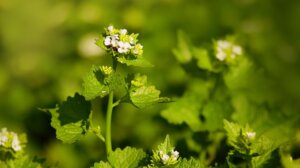
Garlic mustard is not a weed you want growing in your yard because it can be highly invasive. In fact, it inhibits the growth of other plants and pushes out wildflowers, so you want to get rid of it as much as possible.
But if you do have this pesky plant, you can take a little consolation in the fact that it’s edible and high in chlorophyll, vitamin A, and vitamin C. The leaves are quite spicy and pungent, but will add a lot of flavor to food.
Bring the young stems or leaves into your kitchen to cook with instead of throwing them in the garbage. (Older leaves are more bitter and must be thoroughly cooked to remove toxins.)
Edible “Weeds” for Your Youngest-Looking Skin
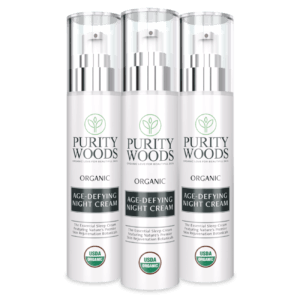
Along with perhaps eating some of the “weeds” growing in your yard, you might want to look into their anti-aging power for skin.
The Age-Defying Night Cream from Purity Woods features organic Japanese knotweed extract, which is a type of knotweed that is packed full of resveratrol. It— and other less weed-like botanicals— naturally rejuvenate skin and reduce the appearance of wrinkles, fine lines, dark spots, and other signs of aging.
The entire formula is USDA Certified Organic (so no hidden toxins), deeply moisturizing, and good for all skin types.
You can look into the Age-Defying Night Cream here, and don’t forget to explore the highly nutritious plants hiding in your backyard.

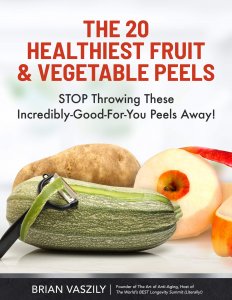
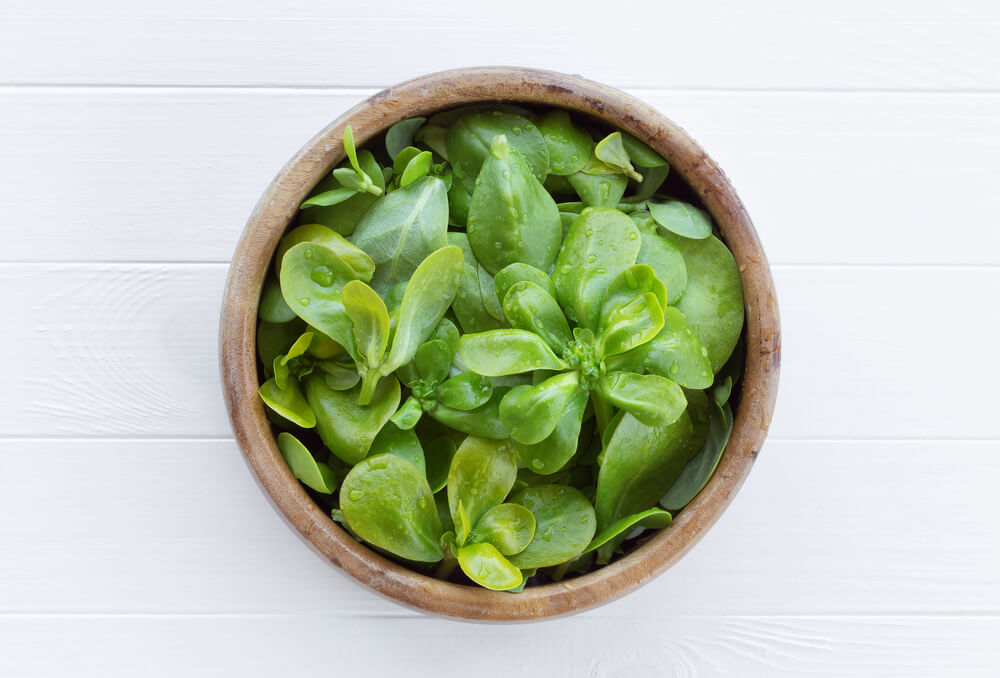
SUCH GREAT INFO I TAKE SOME OF THEM IN A PILL FORM.
Thanks for the well written article; appreciate the fact that you’ve given how to use the so called weeds. These uncultivated plants will become more and more important in the future.
thanks for showing the photos and and explaining which parts of the plants to use.
SUPER!!!
We have a weed that many call bindweed. However, that may not be its true name. Is it edible?
Thank you so much for this. It is very useful, so while I’m growing these weeds to obtain carbon credits, I can pull them right from my own patch and chow down. I will also save at the grocery store because I buy several of these in tincture form.
Very interesting piece, enjoyed learning more about the nutritional value of the wees in our area.
Great info. Thanks! Can’t wait to try some of them.
And there I’ve been throwing purslane away everytime I’ve found in growing where ever it can in my garden. Never again.
Thank you very good information
In late spring/early summer I harvest lots of dandelion leaves from my garden. 1st I boil them for a short time in water then eat them in olive oil and lemon juice may be a little salt. Lovely salad.
Great article. On reading this excellent article I am tempted to grow some of these weed varieties which are native to certain regions of the world, but being hardy would perhaps survive in any region. But again how to get these different plant varieties into my corner of the world where I stay?
Love the article! I’m trying to build an herbal reference book for the “weeds” we have available. This article will definitely be in the book.
Looking differently at my crop of weeds I keep pulling out. Thank you for the article most informative.
Thank you! Great info; we have three of these foods’ “weeds” growing in our yard now. We’ll put your information to use.
Thank you for all you do!
Robin and Dan
P.S. For anyone wondering about Purity Woods, I use Purity Woods day cream and love it 😉 Now I’ll be trying the night cream as well.
Thank you for this article on useful “weeds” Very very helpful
Another note of caution: for decades gasoline had lead additives in it and roadsides are grossly contaminated with lead compounds in the soil from automobile exhaust. Automobile brake linings had asbestos added to them and tires have cadmium in the rubber polymers. DO NOT harvest plants for eating from roadsides or risk lead, asbestos and cadmium ingestion.
Thank you I have most of then cultivated and growing my garden as herbs for health, of which I make drinks for health and healing and energy
I am becoming increasingly interested in edible flowers and weeds. There are a few companies out there that ship them in bulk. I think when I am ready to open a full kitchen experiment these weeds will make my list.
Thank you for a beautifully presented article on our so called weeds aka powerhouses growing in a garden near you!
Thank you for this interesting article. The pictures are very helpful in identifying the plants. Most informative!!!
Wonderful article! I enjoyed it and found it very interesting.
Great article; dandelion salad is well known but I always read you should only use the leaves before the flowers appear?
However, after the dandelions came the “false dandelions” (catsear, hypochaeris radicata) which are also edible but I don’t know their nutritious value. Our garden is suffocating from them…
The reason that I prefer to use dandelion before the flowers appear is just because they are much less bitter then. Once they flower they are still edible, just more bitter. On the other hand, those that are growing in shadier sites are also less bitter. Regarding the catsear, Hypochaeris radicata, I just Googled that with “nutrition” and I see a study done in India and published a few years ago looking at flavonoids and other antioxidants in this plant. This plant appears to be quite nutritious as well.
I have been using dandelion leaves, both raw and cooked, for about 7 years because they have been great at reducing arthritis issues. They are growing well for me in a partly shaded area and they love having been covered in a shredded fir mulch. I eat them all season.
When push comes to shove you will always have weeds to eat!
Great info. As a forager I’d like to add only harvest if you’re 150% certain and if in doubt leave it.. Only take what you need Other than that there’s so much fun harvesting and consuming wild edibles. Chefs are cottoning to these nutritious plants and serving them with a bug mark up.
Thanks for a helpful and informative article! I have eaten purslane, lamb’s quarters, and green amaranth. However, I am now watching oxalate intake and must be more moderate in my portions. Is there a reference to find out the oxalate content of wild edibles? Thanks for your time and consideration, Richard
Oh, thank You……I’ve long known about many of these “weeds” like dandelion but some are new to me and will experiment with them…….Lilith
Thank you very much for this excellent article about the plants that are known as weeds.
Great article, very inspiring. A good follow-up would be a review of phone Plant ID Apps. My garden is overflowing.
Apps like iNaturalist are getting a lot better in recent years, but you should never depend 100% on the identification given by an app. Use is as a first approximation and then look up the plant in other sources.
Great article, informative. I have a number of these so-called weeds in my garden. There are a couple growing in my garden that I wasn’t sure of and one of them you mentioned in your article so it was great to see a picture to confirm what it is.
I like this shout out to weeds! We have harvested dandelion leaves for juicing. Beware, however, that many weeds along roadsides have been sprayed or are covered with toxins from vehicles.
Fantastic article! Thank you so much for everything you do. It’s always a refreshing change when people like yourself give genuine free information and guidance without pushing hard for a sale! (Although I do understand people do need to make a living!)
My land in Spain contains a good selection of those “weeds”.
Thanks for sharing this info. The pictures are very helpful. I love your clear instructions on how to prepare and eat them.